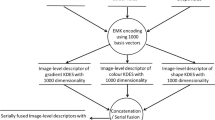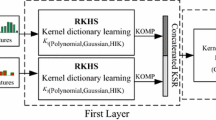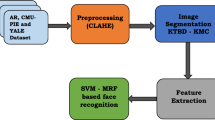Abstract
Patch-level features are essential for achieving good performance in computer vision tasks. Besides wellknown pre-defined patch-level descriptors such as scaleinvariant feature transform (SIFT) and histogram of oriented gradient (HOG), the kernel descriptor (KD) method [1] offers a new way to “grow-up” features from a match-kernel defined over image patch pairs using kernel principal component analysis (KPCA) and yields impressive results.
In this paper, we present efficient kernel descriptor (EKD) and efficient hierarchical kernel descriptor (EHKD), which are built upon incomplete Cholesky decomposition. EKD automatically selects a small number of pivot features for generating patch-level features to achieve better computational efficiency. EHKD recursively applies EKD to form image-level features layer-by-layer. Perhaps due to parsimony, we find surprisingly that the EKD and EHKD approaches achieved competitive results on several public datasets compared with other state-of-the-art methods, at an improved efficiency over KD.
Similar content being viewed by others
References
Bo L F, Ren X F, Fox D. Kernel descriptor for visual recognition. In: Proceedings of the Annual Conference on Neural Information Processing Systems. 2010, 244–252
Bosch A, Mun¯oz X, Marti R.Which is the best way to organize/classify images by content? Image and Vision Computing, 2007, 25(6): 778–791
Lowe D G. Distinctive image features from scale-invariant keypoints. International Journal of Computer Vision, 2004, 60(2): 91–110
Dalal N, Triggs B. Histograms of oriented gradients for human detection. In: Proceedings of the IEEE Conference on Computer Vision and Pattern Recognition. 2005, 886–893
Vogel J, Schiele B. Semantic modeling of natural scenes for contentbased image retrieval. International Journal of Computer Vision, 2007, 72(2): 133–157
Li F F, Perona P. A bayesian hierarchical model for learning natural scene categories. In: Proceedings of the IEEE Conference on Computer Vision and Pattern Recognition. 2005, 524–531
Lazebnik S, Schmid C, Ponce J. Beyond bags of features: spatial pyramid matching for recognizing natural scene categories. In: Proceedings of the IEEE Conference on Computer Vision and Pattern Recognition. 2006, 2169–2178
Bo L F, Sminchisescu C. Efficient match kernel between sets of features for visual recognition. In: Proceedings of the Annual Conference on Neural Information Processing Systems. 2009, 135–143
Schölkopf B, Smola A, Müller K. Nonlinear component analysis as a kernel eigenvalue problem. Neurocomputing, 1998, 10(5): 1299–1319
Xie B J, Liu Y, Zhang H, Yu J. Efficient kernel descriptor for image categorization via pivots selection. In: Proceedings of the IEEE International Conference on Image Processing. 2013, 3479–3483
Wang P, Wang J D, Zeng G, Xu W W, Zha H B, Li S P. Supervised kernel descriptors for visual recognition. In: Proceedings of the IEEE Conference on Computer Vision and Pattern Recognition. 2013, 2858–2865
LeCun Y, Huang F J, Bottou L. Learning methods for generic object recognition with invariance to pose and lighting. In: Proceedings of the IEEE Conference on Computer Vision and Pattern Recognition. 2004, 97–104
Hinton G, Osindero S, Teh Y. A fast learning algorithm for deep belief nets. Neural Computation, 2006, 18(7): 1527–1554
Hinton G, Salakhutdinov R. Reducing the dimensionality of data with neural networks. Science, 2006, 313(5786): 504–507
Krizhevsky A, Sutskever I, Hinton G. Imagenet classification with deep convolutional neural networks. In: Proceedings of the Annual Conference on Neural Information Processing Systems. 2012, 1106–1114
Bo L F, Lai K, Ren X F, Fox D. Object recognition with hierarchical kernel descriptors. In: Proceedings of the IEEE Conference on Computer Vision and Pattern Recognition. 2011, 1729–1736
Fine S, Scheinberg K. Efficient svm training using low-rank kernel representation. Journal of Machine Learning Research, 2001, 2: 243–264
Bach F R, Jordan M I. Kernel independent component analysis. Journal of Machine Learning Research, 2002, 3: 1–48
Oliva A, Torralba A. Modeling the shape of the scene: a holistic representation of the spatial envelope. International Journal of Computer Vision, 2001, 42(3): 145–175
Li F F, Fergus R, Perona P. Learning generative visual models from few training examples: an incremental bayesian approach tested on 101 object categories. Computer Vision and Image Understanding, 2007, 106(1): 59–70
Li L J, Li F F. What, where and who? Classifying events by scene and object recognition. In: Proceedings of the IEEE International Conference on Computer Vision. 2007, 1–8
Quattoni A, Torralba A. Recognizing indoor scenes. In: Proceedings of the IEEE Conference on Computer Vision and Pattern Recognition. 2009, 413–420
Torralba A, Fergus R, Freeman W. 80 million tiny images: a large data set for nonparametric object and scene recognition. IEEE Transactions on Pattern Analysis and Machine Intelligence, 2008, 30(11): 1958–1970
Fan R E, Chang KW, Hsieh C J, Wang X R, Lin C J. Liblinear: a library for large linear classification. Journal of Machine Learning Research, 2008, 9: 1871–1874
Shabou A, Borgne H L. Locality-constrained and spatially regularized coding for scene categorization. In: Proceedings of the IEEE Conference on Computer Vision and Pattern Recognition. 2012, 3618–3625
Wang J J, Yang J C, Yu K, Lv F J, Huang T, Gong Y H. Localityconstrained linear coding for image classification. In: Proceedings of the IEEE Conference on Computer Vision and Pattern Recognition. 2010, 3360–3367
Jia Y Q, Huang C, Darrell T. Beyond spatial pyramids: receptive field learning for pooled image features. In: Proceedings of the IEEE Conference on Computer Vision and Pattern Recognition. 2012, 3370–3377
Boiman O, Shechtman E, Irani M. In defense of nearest-neighbor based image classification. In: Proceedings of the IEEE Conference on Computer Vision and Pattern Recognition. 2008, 1–8
Liu L Q, Wang L, Liu X W. In defense of soft-assignment coding. In:Proceedings of the IEEE International Conference on Computer Vision. 2011, 2486–2493
Zhu J, Li L J, Li F F, Xing E. Large margin learning of upstream scene understanding models. In: Proceedings of the Annual Conference on Neural Information Processing Systems. 2010, 2586–2594
Wu J, Rehg J. Centrist: a visual descriptor for scene categorization. IEEE Transactions on Pattern Analysis and Machine Intelligence, 2011, 33(8): 1489–1501
Li L J, Su H, Xing E, Li F F. Object bank: a high-level image representation for scene classification & semantic feature sparsification. In: Proceedings of the Annual Conference on Neural Information Processing Systems. 2010, 1378–1386
Pandey M, Lazebnik S. Scene recognition and weakly supervised object localization with deformable part-based models. In: Proceedings of the IEEE International Conference on Computer Vision. 2011, 1307–1314
Singh S, Gupta A, Efros A A. Unsupervised discovery of mid-level discriminative patches. In: Proceedings of the European conference on Computer Vision. 2012, 73–86
Ranzato M, Hinton G. Modeling pixel means and covariances using factorized third-order boltzmann machines. In: Proceedings of the IEEE Conference on Computer Vision and Pattern Recognition. 2010, 2551–2558
Le Q, Ngiam J, Chia Z C, Koh P, Ng A. Tiled convolutional neural networks. In: Proceedings of the Annual Conference on Neural Information Processing Systems. 2010, 1279–1287
Yu K, Zhang T. Improved local coordinate coding using local tangents. In: Proceedings of International Conference on Machine Learning. 2010, 1215–1222
Coates A, Lee H, Ng A. An analysis of single-layer networks in unsupervised feature learning. In: Proceedings of International Conference on Artificial Intelligence and Statistics. 2011, 215–223
Author information
Authors and Affiliations
Corresponding author
Additional information
Bojun Xie received the BS degree in computer science and technology, MS degree in computer application from Hebei University, China in 2003 and 2006, respectively. He is currently a PhD candidate in Beijing Jiaotong University China. His interests include machine learning and computer vision.
Yi Liu received BS and PhD degrees from Peking University, China in 2004 and 2009, respectively. His current research interests include reasoning and uncertainty modeling in systems biology, machine learning, information retrieval and 3D geometric processing.
Hui Zhang received the BS degree in information and computing science, MS degree in applied mathematics from Hebei University, China in 2003 and 2006, respectively. He is currently a PhD candidate in Beijing Jiaotong University China. His interests include machine learning and computer vision.
Jian Yu received the BS degree in applied mathematics, MS degree in mathematics, and PhD degree in applied mathematics from Peking University, China in 1991, 1994, and 2000, respectively. He is a professor and head of Institute of Computer Science Beijing Jiaotong University China. His current research interests include fuzzy clustering, pattern recognition, and data mining.
Rights and permissions
About this article
Cite this article
Xie, B., Liu, Y., Zhang, H. et al. Efficient image representation for object recognition via pivots selection. Front. Comput. Sci. 9, 383–391 (2015). https://doi.org/10.1007/s11704-015-4182-7
Received:
Accepted:
Published:
Issue Date:
DOI: https://doi.org/10.1007/s11704-015-4182-7




